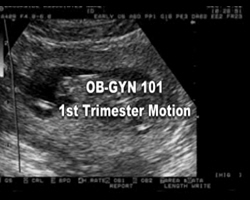This is the Archived Desktop Edition.
You should be transferred to the Newest Edition for Desktop and Mobile within 2 seconds.
|
Lesson 3: Diagnosis of Pregnancy
3-6. POSITIVE SIGNS OF PREGNANCY
Positive signs of pregnancy are those signs that are definitely confirmed as a pregnancy. They include fetal heart sounds, ultrasound scanning of the fetus, palpation of the entire fetus, palpation of fetal movements, x-ray, and actual delivery of an infant.

Figure 3-5. Detecting fetal heartbeat.
a.
Fetal Heart Sounds. The fetal heart begins beating by the 24th day following conception. It is audible with a doppler by 10 weeks of pregnancy and with a fetoscope after the 16th week (see figure 3-5). It is not to be confused with uterine souffle or swishlike tone from pulsating uterine arteries. The normal fetal heart rate is 120 to 160 beats.b.
Ultrasound Scanning of the Fetus. The gestation sac can be seen and photographed. An embryo as early as the 4th week after conception can be identified. The fetal parts begin to appear by the 10th week of gestation.c.
Palpation of the Entire Fetus. Palpation must include the fetus head, back, and upper and lower body parts. This is a positive sign after the 24th week of pregnancy if the woman is not obese.d.
Palpation of Fetal Movement. This is done by a trained examiner. It is easily elicited after 24 weeks of pregnancy.e.
X-ray. An x-ray will identify the entire fetal skeleton by the 12th week. In utero, the fetus receives total body radiation that may lead to genetic or gonadal alterations. An x-ray is not a recommended test for identifying pregnancy.f.
Actual Delivery of An Infant. Self-explanatory.3-7. TESTS UTILIZED TO DETERMINE PREGNANCY
a. Tests are based on the presence of human chorionic gonadotropin (HCG) in the urine or blood.
(1) Urine. This test can be performed accurately 42 days after the last menstrual period or 2 weeks after the first missed period. The first urine specimen of the morning is the best one to use.
(2) Blood. Radioimmunoassays (RIA) can detect HCG in the blood 2 days after implantation or 5 days before the first menstrual period is missed.
NOTE: The Beta HCG level is observed in nuclear medicine. This is expensive to use.
NOTE: HCG levels peak between 50 to 90 days after the last menstrual period.
b. Home pregnancy test kits are easily available and inexpensive. This test allows prenatal care to be started early.
|
The Brookside Associates Medical Education Division is dedicated to the development and dissemination of medical information that may be useful to medical professionals and those in training to become medical professionals. This website is privately-held and not connected to any governmental agency. The views expressed here are those of the authors, and unless otherwise noted, do not necessarily reflect the views of the Brookside Associates, Ltd., any governmental or private organizations. All writings, discussions, and publications on this website are unclassified.
© 2007 Medical Education Division, Brookside Associates, Ltd. All rights reserved


